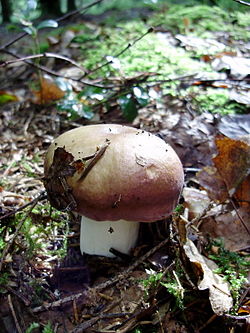| Russula decolorans | |
|---|---|
 | |
| Scientific classification | |
| Kingdom: | Fungi |
| Division: | Basidiomycota |
| Class: | Agaricomycetes |
| Order: | Russulales |
| Family: | Russulaceae |
| Genus: | Russula |
| Species: | R. decolorans |
| Binomial name | |
| Russula decolorans Fr., 1838 | |
| Russula decolorans | |
|---|---|
| Gills on hymenium | |
| Cap is convex or depressed | |
| Hymenium is adnate or adnexed | |
| Stipe is bare | |
| Spore print is yellow to ochre | |
| Ecology is mycorrhizal | |
| Edibility is edible but not recommended | |
Russula decolorans, commonly known as the graying russula, [2] is a Russula mushroom found in forests. Although edible, it resembles several questionable species.
